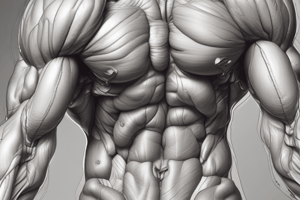Podcast
Questions and Answers
What surrounds each individual muscle fiber (or muscle cell) in skeletal muscles?
What surrounds each individual muscle fiber (or muscle cell) in skeletal muscles?
A thin layer of connective tissue called the endomysium.
What is the main function of the perimysium in skeletal muscles?
What is the main function of the perimysium in skeletal muscles?
To compartmentalize muscle fibers within a muscle, allowing specific movements by activating subsets of muscle fibers within a fascicle.
What is the functional unit of skeletal muscles?
What is the functional unit of skeletal muscles?
Fascicles.
What is the role of collagen in the connective tissue layers of skeletal muscles?
What is the role of collagen in the connective tissue layers of skeletal muscles?
What is the purpose of the endomysium surrounding the extracellular matrix of muscle cells?
What is the purpose of the endomysium surrounding the extracellular matrix of muscle cells?
How do skeletal muscles move the skeleton?
How do skeletal muscles move the skeleton?
What is the middle layer of connective tissue that surrounds fascicles in skeletal muscles?
What is the middle layer of connective tissue that surrounds fascicles in skeletal muscles?
What does the endomysium transfer to the tendons?
What does the endomysium transfer to the tendons?
What is the result of the muscle fibers pulling on the bone?
What is the result of the muscle fibers pulling on the bone?
How do the connective tissue layers facilitate muscle contraction?
How do the connective tissue layers facilitate muscle contraction?
Flashcards are hidden until you start studying
Study Notes
Muscle Contraction
- The interaction between myosin and actin filaments, regulated by troponin and tropomyosin, is essential for muscle contraction.
- Striations in skeletal muscle result from the precise arrangement of thick and thin filaments within the myofibrils.
- The A band represents the overlapping of thick and thin filaments, while the I band consists of thin filaments alone.
Sarcomere Structure and Function
- The sarcomere is the functional unit of myofibrils and plays a crucial role in muscle contraction.
- Actin and myosin filaments overlap within sarcomeres, allowing for the sliding filament mechanism during contraction.
- Sarcomeres can shorten up to 35% of their total length.
Muscle Contraction Mechanism
- Myosin heads bind to exposed sites on actin filaments, forming cross-bridges, and then pivot, pulling the actin filaments towards the center of the sarcomere.
- ATP binding causes the myosin head to detach from the actin filament, and then hydrolyzed, providing energy for the myosin head to return to its original position and repeat the cycle.
Relaxation and Muscle Fiber Structure
- When the nerve impulse stops, calcium ions are pumped back into the sarcoplasmic reticulum, and the muscle fiber relaxes.
- The triad, formed by a transverse tubule and two sarcoplasmic reticulum cisternae, is essential for calcium release and subsequent muscle contraction.
Muscle Physiology
- Skeletal muscles are attached to bones by tendons and produce movements of body parts in relation to each other.
- Muscle cells can respond to electrical signals (action potentials) from nerves or other muscle cells, enabling muscle contraction.
- Excitability is the capacity of muscle fibers to receive and respond to stimuli by changing their electrical states from polarized to depolarized.
Muscle Fiber Organization and Connective Tissue
- Perimysium is a middle layer of connective tissue that surrounds fascicles of muscle fibers.
- The perimysium compartmentalizes the muscle fibers within the muscle, allowing specific movements by activating subsets of muscle fibers within a fascicle.
- Endomysium is a thin layer of connective tissue that surrounds individual muscle fibers.
- The endomysium surrounds the extracellular matrix of muscle cells, transfers force produced by muscle fibers to tendons, and allows for the transfer of tension to move bones.
Studying That Suits You
Use AI to generate personalized quizzes and flashcards to suit your learning preferences.




